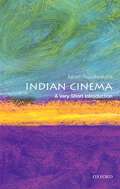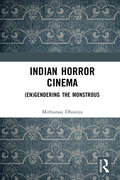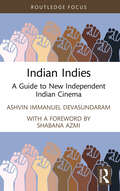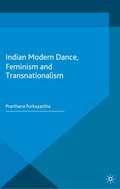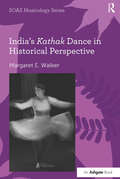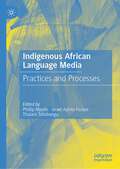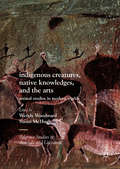- Table View
- List View
Indian Cinema: A Very Short Introduction (Very Short Introductions)
by Ashish RajadhyakshaOne film out of every five made anywhere on earth comes from India. From its beginnings under colonial rule through to the heights of Bollywood , Indian Cinema has challenged social injustices such as caste, the oppression of Indian women, religious intolerance, rural poverty, and the pressures of life in the burgeoning cities. And yet, the Indian movie industry makes only about five percent of Hollywood's annual revenue. In this Very Short Introduction Ashish Rajadhyaksha delves into the political, social, and economic factors which, over time, have shaped Indian Cinema into a fascinating counterculture. Covering everything from silent cinema through to the digital era, Rajadhyaksha examines how the industry reflects the complexity and variety of Indian society through the dramatic changes of the 20th century, and into the beginnings of the 21st. ABOUT THE SERIES: The Very Short Introductions series from Oxford University Press contains hundreds of titles in almost every subject area. These pocket-sized books are the perfect way to get ahead in a new subject quickly. Our expert authors combine facts, analysis, perspective, new ideas, and enthusiasm to make interesting and challenging topics highly readable
Indian Documentary Film and Filmmakers: Practising Independence
by Shweta KishoreBased on detailed onsite observation of documentary production, circulation practices and the analysis of film texts, this book identifies independence as a'tactical practice', contesting the normative definitions and functions assigned to culture, cultural production and producers in a neoliberal economic system.
Indian Documentary Film and Filmmakers: Practising Independence
by Shweta KishoreBased on detailed onsite observation of documentary production, circulation practices and the analysis of film texts, this book identifies independence as a'tactical practice', contesting the normative definitions and functions assigned to culture, cultural production and producers in a neoliberal economic system.
Indian Film Stars: New Critical Perspectives
by Michael LawrenceIndian Film Stars offers original insights and important reappraisals of film stardom in India from the early talkie era of the 1930s to the contemporary period of global blockbusters. The collection represents a substantial intervention to our understanding of the development of film star cultures in India during the 20th and 21st centuries. The contributors seek to inspire and inform further inquiries into the histories of film stardom-the industrial construction and promotion of star personalities, the actual labouring and imagined lifestyles of professional stars, the stars' relationship to specific aesthetic cinematic conventions (such as frontality and song-dance) and production technologies (such as the play-back system and post-synchronization), and audiences' investment in and devotion to specific star bodies-across the country's multiple centres of film production and across the overlapping (and increasingly international) zones of the films' distribution and reception. The star images, star bodies and star careers discussed are examined in relation to a wide range of issues, including the negotiation and contestation of tradition and modernity, the embodiment and articulation of both Indian and non-Indian values and vogues; the representation of gender and sexuality, of race and ethnicity, and of cosmopolitan mobility and transnational migration; innovations and conventions in performance style; the construction and transformation of public persona; the star's association with film studios and the mainstream media; the star's relationship with historical, political and cultural change and memory; and the star's meaning and value for specific (including marginalised) sectors of the audience.
Indian Film Stars: New Critical Perspectives
by Michael LawrenceIndian Film Stars offers original insights and important reappraisals of film stardom in India from the early talkie era of the 1930s to the contemporary period of global blockbusters. The collection represents a substantial intervention to our understanding of the development of film star cultures in India during the 20th and 21st centuries. The contributors seek to inspire and inform further inquiries into the histories of film stardom-the industrial construction and promotion of star personalities, the actual labouring and imagined lifestyles of professional stars, the stars' relationship to specific aesthetic cinematic conventions (such as frontality and song-dance) and production technologies (such as the play-back system and post-synchronization), and audiences' investment in and devotion to specific star bodies-across the country's multiple centres of film production and across the overlapping (and increasingly international) zones of the films' distribution and reception. The star images, star bodies and star careers discussed are examined in relation to a wide range of issues, including the negotiation and contestation of tradition and modernity, the embodiment and articulation of both Indian and non-Indian values and vogues; the representation of gender and sexuality, of race and ethnicity, and of cosmopolitan mobility and transnational migration; innovations and conventions in performance style; the construction and transformation of public persona; the star's association with film studios and the mainstream media; the star's relationship with historical, political and cultural change and memory; and the star's meaning and value for specific (including marginalised) sectors of the audience.
Indian Horror Cinema: (En)gendering the Monstrous
by Mithuraaj DhusiyaThis book studies the hitherto overlooked genre of horror cinema in India. It uncovers some unique and diverse themes that these films deal with, including the fear of the unknown, the supernatural, occult practices, communication with spirits of the deceased, ghosts, reincarnation, figures of vampires, zombies, witches and transmutations of human beings into non-human forms such as werewolves. It focusses on the construction of feminine and masculine subjectivities in select horror films across seven major languages – Hindi, Tamil, Telugu, Kannada, Bangla, Marathi and Malayalam. The author shows that the alienation of the body and bodily functions through the medium of the horror film serves to deconstruct stereotypes of caste, class, gender and anthropocentrism. Some riveting insights emerge thus, such as the masculinist undertow of the possession narrative and how complex structures of resistance accompany the anxieties of culture via the dread of laughter. This original account of Indian cinematic history is accessible yet strongly analytical and includes an exhaustive filmography. The book will interest scholars and researchers in film studies, media and cultural studies, art, popular culture and performance, literature, gender, sociology, South Asian studies, practitioners, filmmakers as well as cinephiles.
Indian Horror Cinema: (En)gendering the Monstrous
by Mithuraaj DhusiyaThis book studies the hitherto overlooked genre of horror cinema in India. It uncovers some unique and diverse themes that these films deal with, including the fear of the unknown, the supernatural, occult practices, communication with spirits of the deceased, ghosts, reincarnation, figures of vampires, zombies, witches and transmutations of human beings into non-human forms such as werewolves. It focusses on the construction of feminine and masculine subjectivities in select horror films across seven major languages – Hindi, Tamil, Telugu, Kannada, Bangla, Marathi and Malayalam. The author shows that the alienation of the body and bodily functions through the medium of the horror film serves to deconstruct stereotypes of caste, class, gender and anthropocentrism. Some riveting insights emerge thus, such as the masculinist undertow of the possession narrative and how complex structures of resistance accompany the anxieties of culture via the dread of laughter. This original account of Indian cinematic history is accessible yet strongly analytical and includes an exhaustive filmography. The book will interest scholars and researchers in film studies, media and cultural studies, art, popular culture and performance, literature, gender, sociology, South Asian studies, practitioners, filmmakers as well as cinephiles.
Indian Indies: A Guide to New Independent Indian Cinema (Routledge Focus on Film Studies)
by Ashvin Immanuel DevasundaramThis book offers a concise and cutting-edge repository of essential information on new independent Indian films, which have orchestrated a recent renaissance in the Bollywood-dominated Indian cinema sphere. Spotlighting a specific timeline, from the Indies’ consolidated emergence in 2010 across a decade of their development, the book takes note of recent transformations in the Indian political, economic, cultural and social matrix and the concurrent release of unflinchingly interrogative and radically evocative films that traverse LGBTQ+ issues, female empowerment, caste discrimination, populist politics and religious violence. A combination of essential Indie-specific information and concise case studies makes this a must-have quick guide to the future torchbearers of Indian cinema for scholars, students, early career researchers and a global audience interested in intersecting aspects of cinema, culture, politics and society in contemporary India.
Indian Indies: A Guide to New Independent Indian Cinema (Routledge Focus on Film Studies)
by Ashvin Immanuel DevasundaramThis book offers a concise and cutting-edge repository of essential information on new independent Indian films, which have orchestrated a recent renaissance in the Bollywood-dominated Indian cinema sphere. Spotlighting a specific timeline, from the Indies’ consolidated emergence in 2010 across a decade of their development, the book takes note of recent transformations in the Indian political, economic, cultural and social matrix and the concurrent release of unflinchingly interrogative and radically evocative films that traverse LGBTQ+ issues, female empowerment, caste discrimination, populist politics and religious violence. A combination of essential Indie-specific information and concise case studies makes this a must-have quick guide to the future torchbearers of Indian cinema for scholars, students, early career researchers and a global audience interested in intersecting aspects of cinema, culture, politics and society in contemporary India.
Indian Modern Dance, Feminism and Transnationalism (New World Choreographies)
by Prarthana PurkayasthaThis book examines modern dance as a form of embodied resistance to political and cultural nationalism in India through the works of five selected modern dance makers: Rabindranath Tagore, Uday Shankar, Shanti Bardhan, Manjusri Chaki Sircar and Ranjabati Sircar.
Indian Movie Entrepreneurship: Not just song and dance (Discovering the Creative Industries)
by Rajeev Kamineni Ruth RentschlerOne of the world’s most prolific creative industries, the Indian movie industry has received scant attention for its spirit of enterprise. Indian Movie Entrepreneurship addresses this omission. For many readers, it might come as a surprise that the Indian movie industry is not just Bollywood and that it has several regional clusters, which are just as vibrant, with a significant output. The authors begin by outlining the contours of Indian cinema and the different regional language hubs that form part of the larger picture. The reader is then offered a glimpse into the actual process of making a film from day zero to release day. The key players in the Indian movie ecosystem are analysed, with the central role of the producer highlighted. Concluding with a look into the future of the entrepreneurial process in the Indian movie industry, the authors illuminate the shifting parameters of distribution and exhibition. Appealing to those interested in understanding the entrepreneurial journey of the Indian movie industry, the book provides a sneak peek into the business landscape of India more broadly.
Indian Movie Entrepreneurship: Not just song and dance (Discovering the Creative Industries)
by Rajeev Kamineni Ruth RentschlerOne of the world’s most prolific creative industries, the Indian movie industry has received scant attention for its spirit of enterprise. Indian Movie Entrepreneurship addresses this omission. For many readers, it might come as a surprise that the Indian movie industry is not just Bollywood and that it has several regional clusters, which are just as vibrant, with a significant output. The authors begin by outlining the contours of Indian cinema and the different regional language hubs that form part of the larger picture. The reader is then offered a glimpse into the actual process of making a film from day zero to release day. The key players in the Indian movie ecosystem are analysed, with the central role of the producer highlighted. Concluding with a look into the future of the entrepreneurial process in the Indian movie industry, the authors illuminate the shifting parameters of distribution and exhibition. Appealing to those interested in understanding the entrepreneurial journey of the Indian movie industry, the book provides a sneak peek into the business landscape of India more broadly.
India's Kathak Dance in Historical Perspective (SOAS Studies in Music)
by Margaret E. WalkerKathak, the classical dance of North India, combines virtuosic footwork and dazzling spins with subtle pantomime and soft gestures. As a global practice and one of India's cultural markers, kathak dance is often presented as heir to an ancient Hindu devotional tradition in which men called Kathakas danced and told stories in temples. The dance's repertoire and movement vocabulary, however, tell a different story of syncretic origins and hybrid history - it is a dance that is both Muslim and Hindu, both devotional and entertaining, and both male and female. Kathak's multiple roots can be found in rural theatre, embodied rhythmic repertoire, and courtesan performance practice, and its history is inextricable from the history of empire, colonialism, and independence in India. Through an analysis both broad and deep of primary and secondary sources, ethnography, iconography and current performance practice, Margaret Walker undertakes a critical approach to the history of kathak dance and presents new data about hereditary performing artists, gendered contexts and practices, and postcolonial cultural reclamation. The account that emerges places kathak and the Kathaks firmly into the living context of North Indian performing arts.
India's Kathak Dance in Historical Perspective (SOAS Studies in Music)
by Margaret E. WalkerKathak, the classical dance of North India, combines virtuosic footwork and dazzling spins with subtle pantomime and soft gestures. As a global practice and one of India's cultural markers, kathak dance is often presented as heir to an ancient Hindu devotional tradition in which men called Kathakas danced and told stories in temples. The dance's repertoire and movement vocabulary, however, tell a different story of syncretic origins and hybrid history - it is a dance that is both Muslim and Hindu, both devotional and entertaining, and both male and female. Kathak's multiple roots can be found in rural theatre, embodied rhythmic repertoire, and courtesan performance practice, and its history is inextricable from the history of empire, colonialism, and independence in India. Through an analysis both broad and deep of primary and secondary sources, ethnography, iconography and current performance practice, Margaret Walker undertakes a critical approach to the history of kathak dance and presents new data about hereditary performing artists, gendered contexts and practices, and postcolonial cultural reclamation. The account that emerges places kathak and the Kathaks firmly into the living context of North Indian performing arts.
India's New Independent Cinema: Rise of the Hybrid (Routledge Advances in Film Studies)
by Ashvin Immanuel DevasundaramThis is the first-ever book on the rise of the new wave of independent Indian films that is revolutionising Indian cinema. Contemporary scholarship on Indian cinema so far has focused asymmetrically on Bollywood—India’s dominant cultural export. Reversing this trend, this book provides an in-depth examination of the burgeoning independent Indian film sector. It locates the new 'Indies' as a glocal hybrid film form—global in aesthetic and local in content. They critically engage with a diverse socio-political spectrum of ‘state of the nation’ stories; from farmer suicides, disenfranchised urban youth and migrant workers to monks turned anti-corporation animal rights agitators. This book provides comprehensive analyses of definitive Indie new wave films including Peepli Live (2010), Dhobi Ghat (2010), The Lunchbox (2013) and Ship of Theseus (2013). It explores how subversive Indies, such as polemical postmodern rap-musical Gandu (2010) transgress conventional notions of ‘traditional Indian values’, and collide with state censorship regulations. This timely and pioneering analysis shows how the new Indies have emerged from a middle space between India’s globalising present and traditional past. This book draws on in-depth interviews with directors, actors, academics and members of the Indian censor board, and is essential reading for anyone seeking an insight into a current Indian film phenomenon that could chart the future of Indian cinema.
India's New Independent Cinema: Rise of the Hybrid (Routledge Advances in Film Studies)
by Ashvin Immanuel DevasundaramThis is the first-ever book on the rise of the new wave of independent Indian films that is revolutionising Indian cinema. Contemporary scholarship on Indian cinema so far has focused asymmetrically on Bollywood—India’s dominant cultural export. Reversing this trend, this book provides an in-depth examination of the burgeoning independent Indian film sector. It locates the new 'Indies' as a glocal hybrid film form—global in aesthetic and local in content. They critically engage with a diverse socio-political spectrum of ‘state of the nation’ stories; from farmer suicides, disenfranchised urban youth and migrant workers to monks turned anti-corporation animal rights agitators. This book provides comprehensive analyses of definitive Indie new wave films including Peepli Live (2010), Dhobi Ghat (2010), The Lunchbox (2013) and Ship of Theseus (2013). It explores how subversive Indies, such as polemical postmodern rap-musical Gandu (2010) transgress conventional notions of ‘traditional Indian values’, and collide with state censorship regulations. This timely and pioneering analysis shows how the new Indies have emerged from a middle space between India’s globalising present and traditional past. This book draws on in-depth interviews with directors, actors, academics and members of the Indian censor board, and is essential reading for anyone seeking an insight into a current Indian film phenomenon that could chart the future of Indian cinema.
Indie Reframed: Women’s Filmmaking and Contemporary American Independent Cinema (Traditions in American Cinema)
by Linda Badley Claire PerkinsExplores the films, practitioners, production and distribution contexts that currently represent American women’s independent cinemaWith the consolidation of ‘indie’ culture in the 21st century, female filmmakers face an increasingly indifferent climate. Within this sector, women work across all aspects of writing, direction, production, editing and design, yet the dominant narrative continues to construe ‘maverick’ white male auteurs such as Quentin Tarantino or Wes Anderson as the face of indie discourse. Defying the formulaic myths of the mainstream ‘chick flick’ and the ideological and experimental radicalism of feminist counter-cinema alike, women’s indie filmmaking is neither ironic, popular nor political enough to be readily absorbed into pre-existing categories. This ground-breaking collection, the first sustained examination of the work of female practitioners within American independent cinema, reclaims the ‘difference’ of female indie filmmaking. Through a variety of case studies of directors, writers and producers such as Ava DuVernay, Lena Dunham and Christine Vachon, contributors explore the innovation of a range of female practitioners by attending to the sensibilities, ideologies and industrial practices that distinguish their work – while embracing the ‘in-between’ space in which the narratives they represent and embody can be revealed.Key FeaturesCovers American women’s independent cinema since the late 1970sAnalyses the work of acclaimed but critically overlooked female practitioners such as Kelly Reichardt, Christine Vachon, Miranda July, Kasi Lemmons, Nicole Holofcener, Mira Nair, Lisa Cholodenko, Megan Ellison, Lynn Shelton, Ava DuVernay, Mary Harron and Debra GranikDistinguishes four different approaches to analysing women’s independent cinema through: production and industry perspectives; genre and other classificatory modalities; political, cultural, social and professional identities; and collaborative and collectivist practicesContributorsJohn Alberti, Northern Kentucky UniversityLinda Badley, Middle Tennessee State UniversityCynthia Baron, Bowling Green State UniversityShelley Cobb, University of SouthamptonCorinn Columpar, University of TorontoChris Holmlund, University of Tennessee-KnoxvilleGeoff King, Brunel University, LondonChristina Lane, University of MiamiJames Lyons, University of ExeterKathleen A. McHugh, UCLAKent A. Ono, University of UtahLydia Papadimitriou, Liverpool John Moores UniversityClaudia Costa Pederson, Wichita State UniversityClaire Perkins, Monash UniversitySarah Projansky, University of UtahMaria San Filippo, Goucher CollegeMichele Schreiber, Emory UniversitySarah E. S. Sinwell, University of UtahYannis Tzioumakis, University of LiverpoolPatricia White, Swarthmore CollegePatricia R. Zimmermann, Ithaca College
Indie Reframed: Women’s Filmmaking and Contemporary American Independent Cinema (Traditions in American Cinema)
by Linda Badley Claire PerkinsExplores the films, practitioners, production and distribution contexts that currently represent American women’s independent cinemaWith the consolidation of ‘indie’ culture in the 21st century, female filmmakers face an increasingly indifferent climate. Within this sector, women work across all aspects of writing, direction, production, editing and design, yet the dominant narrative continues to construe ‘maverick’ white male auteurs such as Quentin Tarantino or Wes Anderson as the face of indie discourse. Defying the formulaic myths of the mainstream ‘chick flick’ and the ideological and experimental radicalism of feminist counter-cinema alike, women’s indie filmmaking is neither ironic, popular nor political enough to be readily absorbed into pre-existing categories. This ground-breaking collection, the first sustained examination of the work of female practitioners within American independent cinema, reclaims the ‘difference’ of female indie filmmaking. Through a variety of case studies of directors, writers and producers such as Ava DuVernay, Lena Dunham and Christine Vachon, contributors explore the innovation of a range of female practitioners by attending to the sensibilities, ideologies and industrial practices that distinguish their work – while embracing the ‘in-between’ space in which the narratives they represent and embody can be revealed.Key FeaturesCovers American women’s independent cinema since the late 1970sAnalyses the work of acclaimed but critically overlooked female practitioners such as Kelly Reichardt, Christine Vachon, Miranda July, Kasi Lemmons, Nicole Holofcener, Mira Nair, Lisa Cholodenko, Megan Ellison, Lynn Shelton, Ava DuVernay, Mary Harron and Debra GranikDistinguishes four different approaches to analysing women’s independent cinema through: production and industry perspectives; genre and other classificatory modalities; political, cultural, social and professional identities; and collaborative and collectivist practicesContributorsJohn Alberti, Northern Kentucky UniversityLinda Badley, Middle Tennessee State UniversityCynthia Baron, Bowling Green State UniversityShelley Cobb, University of SouthamptonCorinn Columpar, University of TorontoChris Holmlund, University of Tennessee-KnoxvilleGeoff King, Brunel University, LondonChristina Lane, University of MiamiJames Lyons, University of ExeterKathleen A. McHugh, UCLAKent A. Ono, University of UtahLydia Papadimitriou, Liverpool John Moores UniversityClaudia Costa Pederson, Wichita State UniversityClaire Perkins, Monash UniversitySarah Projansky, University of UtahMaria San Filippo, Goucher CollegeMichele Schreiber, Emory UniversitySarah E. S. Sinwell, University of UtahYannis Tzioumakis, University of LiverpoolPatricia White, Swarthmore CollegePatricia R. Zimmermann, Ithaca College
Indigeneity and the Decolonizing Gaze: Transnational Imaginaries, Media Aesthetics, and Social Thought
by Robert StamAgainst the long historical backdrop of 1492, Columbus, and the Conquest, Robert Stam's wide-ranging study traces a trajectory from the representation of indigenous peoples by others to self-representation by indigenous peoples, often as a form of resistance and rebellion to colonialist or neoliberal capitalism, across an eclectic range of forms of media, arts, and social philosophy. Spanning national and transnational media in countries including the US, Brazil, Canada, France, Germany, and Italy, Stam orchestrates a dialogue between the western mediated gaze on the 'Indian' and the indigenous gaze itself, especially as incarnated in the burgeoning movement of “indigenous media,” that is, the use of audio-visual-digital media for the social and cultural purposes of indigenous peoples themselves. Drawing on examples from cinema, literature, music, video, painting and stand-up comedy, Stam shows how indigenous artists, intellectuals and activists are responding to the multiple crises - climatological, economic, political, racial, and cultural - confronting the world.
Indigeneity and the Decolonizing Gaze: Transnational Imaginaries, Media Aesthetics, and Social Thought
by Robert StamAgainst the long historical backdrop of 1492, Columbus, and the Conquest, Robert Stam's wide-ranging study traces a trajectory from the representation of indigenous peoples by others to self-representation by indigenous peoples, often as a form of resistance and rebellion to colonialist or neoliberal capitalism, across an eclectic range of forms of media, arts, and social philosophy. Spanning national and transnational media in countries including the US, Brazil, Canada, France, Germany, and Italy, Stam orchestrates a dialogue between the western mediated gaze on the 'Indian' and the indigenous gaze itself, especially as incarnated in the burgeoning movement of “indigenous media,” that is, the use of audio-visual-digital media for the social and cultural purposes of indigenous peoples themselves. Drawing on examples from cinema, literature, music, video, painting and stand-up comedy, Stam shows how indigenous artists, intellectuals and activists are responding to the multiple crises - climatological, economic, political, racial, and cultural - confronting the world.
Indigeneity in Latin American Cinema
by Milton Fernando RodriguezIndigeneity in Latin American Cinema explores how contemporary films (2000-2020) participate in the evolution and circulation of images and sounds that in many ways define how indigenous communities are imagined, at a local, regional and global scale. The volume reviews the diversity of portrayals from a chronological, geopolitical, linguistic, epistemic-ontological, transnational and intersectional, paradigm-changing and self-representational perspective, allocating one chapter to each theme. The corpus of this study consists of 68 fictional features directed by non-indigenous filmmakers, 31 cinematic works produced by indigenous directors/communities, and 22 Cine Regional (Regional Cinema) films. The book also draws upon a significant number of engravings, drawings, paintings, photographs and films, produced between 1493 and 2000, as primary sources for the historical review of the visual representations of indigeneity. Through content and close (textual) analysis, interviews with audiences, surveys and social media posts analysis, the author looks at the contexts in which Latin American films circulate in international festivals and the paradigm shifts introduced by self-representational cinema and Roma (Mexico, 2018). Conclusively, the author provides the foundations of histrionic indigeneity, a theory that explains how overtly histrionic proclivities play a significant role in depictions of an imagined indigenous Other in recent films.
Indigeneity in Latin American Cinema
by Milton Fernando RodriguezIndigeneity in Latin American Cinema explores how contemporary films (2000-2020) participate in the evolution and circulation of images and sounds that in many ways define how indigenous communities are imagined, at a local, regional and global scale. The volume reviews the diversity of portrayals from a chronological, geopolitical, linguistic, epistemic-ontological, transnational and intersectional, paradigm-changing and self-representational perspective, allocating one chapter to each theme. The corpus of this study consists of 68 fictional features directed by non-indigenous filmmakers, 31 cinematic works produced by indigenous directors/communities, and 22 Cine Regional (Regional Cinema) films. The book also draws upon a significant number of engravings, drawings, paintings, photographs and films, produced between 1493 and 2000, as primary sources for the historical review of the visual representations of indigeneity. Through content and close (textual) analysis, interviews with audiences, surveys and social media posts analysis, the author looks at the contexts in which Latin American films circulate in international festivals and the paradigm shifts introduced by self-representational cinema and Roma (Mexico, 2018). Conclusively, the author provides the foundations of histrionic indigeneity, a theory that explains how overtly histrionic proclivities play a significant role in depictions of an imagined indigenous Other in recent films.
Indigenous African Language Media: Practices and Processes
by Phillip Mpofu Israel Ayinla Fadipe Thulani TshabanguThe book contributes to the sparse academic literature on African and minority language media research. It serves as a compendium of experiences, activities and case studies on the use of native language media. Chapters in this book make theoretical, methodical and empirical contributions about indigenous African language media that are affected by structural factors of politics, technology, culture and economy and how they are creatively produced and appropriated by their audiences across African cultures and contexts. This book explores indigenous African language media about media representations, media texts and contents, practice-based activities, audience reception and participation, television, popular culture and cinema, peace and conflict resolution, health and environmental crisis communication, citizen journalism, ethnic and identity formation, beat analysis and investigative journalism, and corporate communication. There are hardly any similar works that focus on the various issues relating to this body of knowledge. The book provides a valuable companion for scholars in various fields like communication, media studies, African studies, African languages, popular culture, journalism, health and environmental communication.
Indigenous Creatures, Native Knowledges, and the Arts: Animal Studies in Modern Worlds
by Wendy Woodward Susan MchughThis volume illuminates how creative representations remain sites of ongoing struggles to engage with animals in indigenous epistemologies. Traditionally imagined in relation to spiritual realms and the occult, animals have always been more than primitive symbols of human relations. Whether as animist gods, familiars, conduits to ancestors, totems, talismans, or co-creators of multispecies cosmologies, animals act as vital players in the lives of cultures. From early days in colonial contact zones through contemporary expressions in art, film, and literature, the volume’s unique emphasis on Southern Africa and North America – historical loci of the greatest ranges of species and linguistic diversity – help to situate how indigenous knowledges of human-animal relations are being adapted to modern conditions of life shared across species lines.
Indigenous Creatures, Native Knowledges, and the Arts: Animal Studies in Modern Worlds
by Wendy Woodward Susan MchughThis volume illuminates how creative representations remain sites of ongoing struggles to engage with animals in indigenous epistemologies. Traditionally imagined in relation to spiritual realms and the occult, animals have always been more than primitive symbols of human relations. Whether as animist gods, familiars, conduits to ancestors, totems, talismans, or co-creators of multispecies cosmologies, animals act as vital players in the lives of cultures. From early days in colonial contact zones through contemporary expressions in art, film, and literature, the volume’s unique emphasis on Southern Africa and North America – historical loci of the greatest ranges of species and linguistic diversity – help to situate how indigenous knowledges of human-animal relations are being adapted to modern conditions of life shared across species lines.
